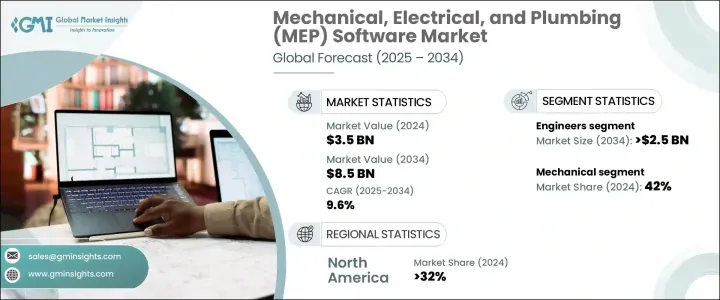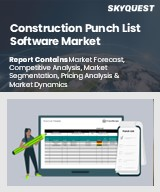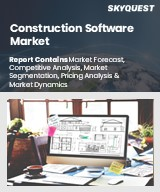
|
시장보고서
상품코드
1708134
세계의 MEP(기계, 전기, 배관) 소프트웨어 시장 기회, 성장 촉진요인, 산업 동향 분석 및 예측(2025-2034년)Mechanical, Electrical, and Plumbing (MEP) Software Market Opportunity, Growth Drivers, Industry Trend Analysis, and Forecast 2025 - 2034 |
||||||
세계 MEP(기계, 전기, 배관) 소프트웨어 시장은 2024년 35억 달러에 달했고, 2025-2034년 연평균 9.6%의 성장률을 보일 것으로 전망됩니다.
이 시장은 건설 업계의 첨단 디지털 솔루션 채택 확대에 힘입어 크게 성장하고 있습니다. 현대 건축물에서는 기계, 전기, 배관 구성 요소 간의 원활한 통합에 대한 수요가 증가하고 있으며, MEP(기계, 전기, 배관) 소프트웨어는 엔지니어, 계약자, 건축가에게 필수적인 도구가 되고 있습니다. 이 소프트웨어는 설계를 간소화하고, 협업을 강화하며, 착공 전에 잠재적인 시스템 충돌을 식별하여 프로젝트 위험을 최소화합니다.

빌딩 정보 모델링(BIM)의 급속한 통합은 주요 성장 동력으로, BIM은 데이터가 풍부한 3D 모델링을 용이하게 하고 여러 이해관계자가 실시간으로 협력하여 건축 설계를 최적화할 수 있게 해줍니다. 엔지니어와 계약자들은 비효율성을 감지하고, 프로젝트 실행을 개선하고, 운영 비용을 절감하기 위해 이 기술을 활용하고 있습니다. 인프라 프로젝트의 복잡성 증가와 함께 디지털 건설 방식으로의 전환은 다양한 응용 분야에서 MEP(기계, 전기, 배관) 소프트웨어의 보급에 박차를 가하고 있습니다.
| 시장 범위 | |
|---|---|
| 시작 연도 | 2024년 |
| 예측 연도 | 2025-2034년 |
| 시작 금액 | 35억 달러 |
| 예상 금액 | 85억 달러 |
| CAGR | 9.6% |
스마트 빌딩 기술이 시장 성장을 더욱 가속화하고 있습니다. 상업용 건물과 주거용 건물에 IoT, AI, 자동화가 도입되면서 조명, HVAC, 보안과 같은 중요한 기능을 지원하는 효율적인 MEP 시스템에 대한 요구가 증가하고 있습니다. 더 많은 건물이 지능형, 상호 연결된 시스템으로 전환함에 따라 에너지 효율과 지속가능성 최적화를 보장하는 첨단 MEP 솔루션에 대한 수요는 계속 증가하고 있습니다. 전 세계 정부 및 규제 기관들도 에너지 효율적인 건물 설계를 장려하고 있으며, 이는 MEP(기계, 전기, 배관) 소프트웨어 제공업체에게 유리한 기회를 창출하고 있습니다.
시장은 최종 사용자별로 구분되며, 2024년 엔지니어가 30%의 점유율을 차지할 것으로 예측됩니다. 엔지니어는 필수적인 건축 시스템의 설계 및 구현을 담당하기 때문에 MEP(기계, 전기, 배관) 소프트웨어의 주요 채택자입니다. 기계, 전기, 배관 구성요소를 건설 프로젝트에 통합하는 전문 지식이 소프트웨어 수요를 지속적으로 주도하고 있으며, 이 분야가 시장을 주도하고 있습니다.
용도별로는 첨단 HVAC 시스템에 대한 수요 증가로 인해 기계 분야가 2024년 시장 점유율의 42%를 차지했으며, MEP(기계, 전기, 배관) 소프트웨어는 효율적인 난방, 환기, 공조 솔루션을 설계하고 최적의 공기 흐름과 실내 쾌적성을 보장하는 데 있어 매우 중요한 역할을 합니다. 매우 중요합니다. 에너지 효율이 높은 공조 제어 시스템에 대한 관심이 높아짐에 따라, 기계적인 응용 분야에서의 MEP 솔루션에 대한 수요는 꾸준히 증가하고 있습니다.
북미는 2024년 MEP(기계, 전기, 배관) 소프트웨어 시장의 32%를 차지했으며, 주거, 산업, 상업용 건축의 지속적인 성장에 힘입어 성장세를 이어갈 것으로 전망됩니다. 이 지역의 인프라 프로젝트가 급증함에 따라 혁신적인 MEP 솔루션에 대한 수요가 증가하고 있으며, 이는 중요한 빌딩 시스템을 정밀하게 설계, 최적화 및 관리할 수 있게 해줍니다. 이 지역에서는 스마트 시티와 그린 빌딩에 대한 관심이 높아지면서 시장 성장의 주요 기여자로서의 입지가 더욱 강화되고 있습니다.
목차
제1장 조사 방법과 조사 범위
제2장 주요 요약
제3장 업계 인사이트
- 생태계 분석
- 공급업체 상황
- 소프트웨어 프로바이더
- 기술 제공업체
- 컨설팅 및 통합 서비스 제공업체
- 최종 용도
- 이익률 분석
- 기술 및 혁신 상황
- 특허 분석
- 이용 사례
- 주요 뉴스 및 이니셔티브
- 규제 상황
- 영향요인
- 성장 촉진요인
- 업계의 잠재적 리스크&과제
- 성장 가능성 분석
- Porter's Five Forces 분석
- PESTEL 분석
제4장 경쟁 구도
- 서론
- 기업 점유율 분석
- 경쟁 포지셔닝 매트릭스
- 전략 전망 매트릭스
제5장 시장 추산 및 예측 : 소프트웨어별, 2021년-2034년
- 주요 동향
- BIM 기반
- CAD 기반
제6장 시장 추산 및 예측 : 전개 형태별, 2021년-2034년
- 주요 동향
- 온프레미스
- 클라우드 기반
- 하이브리드
제7장 시장 추산 및 예측 : 용도별, 2021년-2034년
- 주요 동향
- 기계
- 전기
- 배관
제8장 시장 추산 및 예측 : 최종 용도별, 2021년-2034년
- 주요 동향
- 엔지니어
- 계약업체
- 건축가
- 시설 관리자
- 기타
제9장 시장 추산 및 예측 : 지역별, 2021년-2034년
- 주요 동향
- 북미
- 미국
- 캐나다
- 유럽
- 영국
- 독일
- 프랑스
- 이탈리아
- 스페인
- 러시아
- 북유럽
- 아시아태평양
- 중국
- 인도
- 일본
- 호주
- 한국
- 동남아시아
- 라틴아메리카
- 브라질
- 멕시코
- 아르헨티나
- 중동 및 아프리카
- 아랍에미리트(UAE)
- 남아프리카공화국
- 사우디아라비아
제10장 기업 개요
- 4MCAD
- ACCA Software
- Access Technology
- Aptus Engineering
- Autodesk
- Bentley Systems
- Cadison
- CYPE
- Design Master Software
- ePROMIS
- eVolve MEP
- Graphisoft
- MagiCAD Group
- Nemetschek Group
- On Center Software
- Procore
- ProgeSOFT
- Renga Software
- SrinSoft
- Trimble
The Global MEP Software Market reached USD 3.5 billion in 2024 and is projected to grow at a CAGR of 9.6% between 2025 and 2034. The market is witnessing significant expansion, driven by the growing adoption of cutting-edge digital solutions in the construction industry. Increasing demand for seamless integration between mechanical, electrical, and plumbing components in modern buildings has made MEP software an essential tool for engineers, contractors, and architects. This software streamlines design, enhances collaboration, and minimizes project risks by identifying potential system conflicts before construction begins.

The rapid integration of Building Information Modeling (BIM) is a key growth driver. BIM facilitates data-rich 3D modeling, enabling multiple stakeholders to collaborate in real time and optimize building design. Engineers and contractors are increasingly leveraging this technology to detect inefficiencies, improve project execution, and reduce operational costs. The shift toward digital construction methodologies, coupled with the rising complexity of infrastructure projects, has fueled the widespread adoption of MEP software across various applications.
| Market Scope | |
|---|---|
| Start Year | 2024 |
| Forecast Year | 2025-2034 |
| Start Value | $3.5 Billion |
| Forecast Value | $8.5 Billion |
| CAGR | 9.6% |
Smart building technologies are further accelerating market growth. The rising incorporation of IoT, AI, and automation into commercial and residential buildings requires efficient MEP systems to support critical functions such as lighting, HVAC, and security. As more buildings transition to intelligent, interconnected systems, the demand for advanced MEP solutions continues to rise, ensuring optimized energy efficiency and sustainability. Governments and regulatory bodies worldwide are also pushing for energy-efficient building designs, creating lucrative opportunities for MEP software providers.
The market is segmented by end users, with engineers holding a 30% share in 2024. Engineers remain the primary adopters of MEP software due to their role in designing and implementing essential building systems. Their expertise in integrating mechanical, electrical, and plumbing components into construction projects continues to drive software demand, making this segment the dominant force in the market.
By application, the mechanical segment accounted for 42% of the market share in 2024, driven by the increasing need for advanced HVAC systems. MEP software is crucial in designing efficient heating, ventilation, and air conditioning solutions, ensuring optimal airflow distribution and indoor comfort. With the growing emphasis on energy-efficient climate control systems, the demand for MEP solutions in mechanical applications remains strong.
North America accounted for 32% of the MEP Software Market in 2024, supported by ongoing expansion in residential, industrial, and commercial construction. The surge in infrastructure projects across the region has intensified the need for innovative MEP solutions, enabling precise design, optimization, and management of critical building systems. The region's increasing focus on smart cities and green buildings further strengthens its position as a major contributor to market growth.
Table of Contents
Chapter 1 Methodology & Scope
- 1.1 Research design
- 1.1.1 Research approach
- 1.1.2 Data collection methods
- 1.2 Base estimates & calculations
- 1.2.1 Base year calculation
- 1.2.2 Key trends for market estimation
- 1.3 Forecast model
- 1.4 Primary research and validation
- 1.4.1 Primary sources
- 1.4.2 Data mining sources
- 1.5 Market scope & definition
Chapter 2 Executive Summary
- 2.1 Industry 3600 synopsis, 2021 - 2034
Chapter 3 Industry Insights
- 3.1 Industry ecosystem analysis
- 3.2 Supplier landscape
- 3.2.1 Software providers
- 3.2.2 Technology providers
- 3.2.3 Consulting and integration service providers
- 3.2.4 End Use
- 3.3 Profit margin analysis
- 3.4 Technology & innovation landscape
- 3.5 Patent analysis
- 3.6 Use cases
- 3.7 Key news & initiatives
- 3.8 Regulatory landscape
- 3.9 Impact forces
- 3.9.1 Growth drivers
- 3.9.1.1 Rising demand for smart building technologies
- 3.9.1.2 Digitalization of the construction industry
- 3.9.1.3 Increased adoption of BIM (building information modeling)
- 3.9.1.4 Global urbanization and infrastructure development
- 3.9.1.5 Focus on energy efficiency and sustainability
- 3.9.2 Industry pitfalls & challenges
- 3.9.2.1 High initial costs and investment
- 3.9.2.2 Complexity of software integration
- 3.9.1 Growth drivers
- 3.10 Growth potential analysis
- 3.11 Porter's analysis
- 3.12 PESTEL analysis
Chapter 4 Competitive Landscape, 2024
- 4.1 Introduction
- 4.2 Company market share analysis
- 4.3 Competitive positioning matrix
- 4.4 Strategic outlook matrix
Chapter 5 Market Estimates & Forecast, By Software, 2021 - 2034 ($Bn)
- 5.1 Key trends
- 5.2 BIM-based
- 5.3 CAD-based
Chapter 6 Market Estimates & Forecast, By Deployment, 2021 - 2034 ($Bn)
- 6.1 Key trends
- 6.2 On-premises
- 6.3 Cloud-based
- 6.4 Hybrid
Chapter 7 Market Estimates & Forecast, By Application, 2021 - 2034 ($Bn)
- 7.1 Key trends
- 7.2 Mechanical
- 7.3 Electrical
- 7.4 Plumbing
Chapter 8 Market Estimates & Forecast, By End Use, 2021 - 2034 ($Bn)
- 8.1 Key trends
- 8.2 Engineers
- 8.3 Contractors
- 8.4 Architects
- 8.5 Facility managers
- 8.6 Others
Chapter 9 Market Estimates & Forecast, By Region, 2021 - 2034 ($Bn)
- 9.1 Key trends
- 9.2 North America
- 9.2.1 U.S.
- 9.2.2 Canada
- 9.3 Europe
- 9.3.1 UK
- 9.3.2 Germany
- 9.3.3 France
- 9.3.4 Italy
- 9.3.5 Spain
- 9.3.6 Russia
- 9.3.7 Nordics
- 9.4 Asia Pacific
- 9.4.1 China
- 9.4.2 India
- 9.4.3 Japan
- 9.4.4 Australia
- 9.4.5 South Korea
- 9.4.6 Southeast Asia
- 9.5 Latin America
- 9.5.1 Brazil
- 9.5.2 Mexico
- 9.5.3 Argentina
- 9.6 MEA
- 9.6.1 UAE
- 9.6.2 South Africa
- 9.6.3 Saudi Arabia
Chapter 10 Company Profiles
- 10.1 4MCAD
- 10.2 ACCA Software
- 10.3 Access Technology
- 10.4 Aptus Engineering
- 10.5 Autodesk
- 10.6 Bentley Systems
- 10.7 Cadison
- 10.8 CYPE
- 10.9 Design Master Software
- 10.10 ePROMIS
- 10.11 eVolve MEP
- 10.12 Graphisoft
- 10.13 MagiCAD Group
- 10.14 Nemetschek Group
- 10.15 On Center Software
- 10.16 Procore
- 10.17 ProgeSOFT
- 10.18 Renga Software
- 10.19 SrinSoft
- 10.20 Trimble















